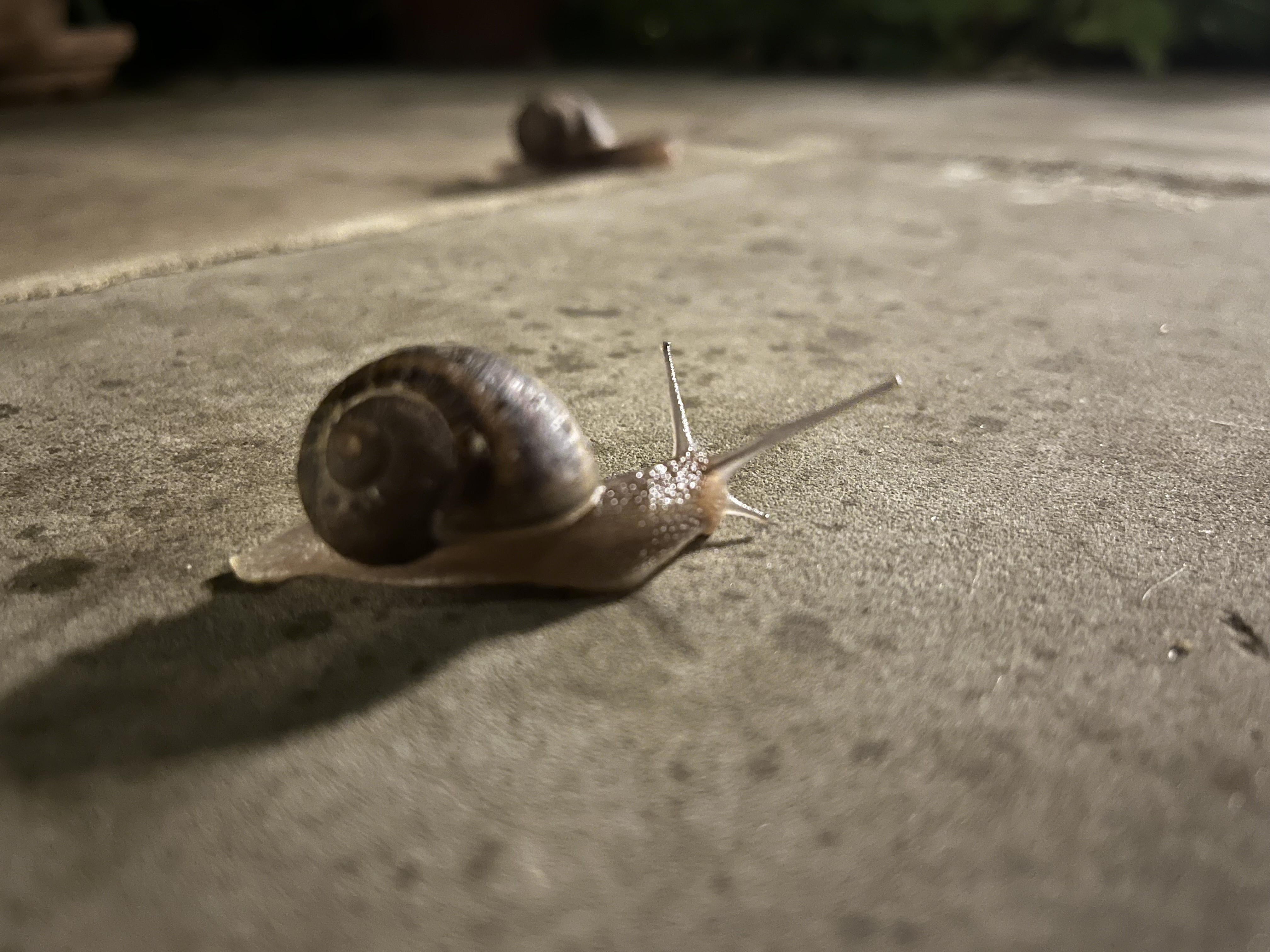"And the snail, the peaceful bourgeois of the narrow trail, contemplates the landscape."
—Federico Garcia Lorca
Run, rest, run…yet, how often do we consider pace? A snail’s progress has much to offer. Their even pace has defined our notions of movement and fired our imaginations. (Notwithstanding their astounding absence of feet.)
We don’t see many snails at our third-floor walk-up. When I found a mottled shell occupied in our window box, I was elated. She (snails are hermaphrodites; thus, I felt her gender was my prerogative) arrived through herb pots, black mint, and marjoram. We nodded acquaintance; I showed her around.

Carefully, very carefully, I slipped her onto a spoon. A snail is not a slug in a shell. A snail without a body or even a punctured shell will die. Shells are astoundingly light and delicate.
She absorbed the sights as we went, moving her head, squirming in the shaded kitchen, and shrinking in the sunny spare room. I moved slowly, evenly, and with considered steps. She twiddled rapturously as we passed the bright-blue work of English ceramicist Fenella Elms.
I tipped the spoon, and she took off across the Perspex, crossing the patterned small discs with the ease and rhythm inherent in the piece itself. She moved with determination and purpose, befitting our understanding of snails.

Pace is not the same as a break, although they have similar effects. A break is a rest, an exhale, or an inhale. Pace, especially a slow, even one, is how we go where we go. The benefits of commanding pace are subtle but endearing. Steadiness goes hand in hand with a fixed gaze, focusing on what is meaningful and ignoring the extraneous.
In Federico Garcia Lorca’s existential poem, the snail is an adventurous soul driven by a simple, authentic need:
And the snail, the peaceful
bourgeois of the narrow trail,
contemplates the landscape.
The divine serenity
of Nature
gave him courage and faith,
and forgetting the troubles
of his home, he longed
to see the end of the path.
From Federico Garcia Lorca’s “The Dialogue of Two Snails”
My little snail set a beautiful pace; I wanted to see what she’d do with edges and corners. I introduced her to Isobel Egan’s “Miniature Spaces,” one of my favorite pieces whose removable boxes I rearrange to suit my moods. The porcelain is cold and fragile. To avoid breakage, I have to move them slowly; it’s an exercise in pace. They make a lovely noise, scraping against one another.
The snail sniffed, cautious, contemplative, seeking the best path. She moved pretty slowly, but she picked up the longer she remained. Ever guarded, however.

Virginia Woolf, in her inimitable modern way, paid homage to the determined snail:
Read more about English gardeners their social influence and habits in There Is No Collective Noun for Gardeners.
Brown cliffs with deep green lakes in the hollows, flat, blade-like trees that waved from root to tip, round boulders of grey stone, vast crumpled surfaces of a thin cracking texture – all these objects lay across the snail’s progress between one stalk and another to his goal.
From Virginia Woolf’s “Kew Gardens”
How comforting that at any point in time, millions of snails are moving slowly towards their most desired end.
 Snails in my garden at night.
Snails in my garden at night.My snail was pooped. She had covered tens of inches.
I put a measure of soil in the spoon and scooped her up. We spoke softly of art, style, color and texture, rocks and pine cones, eternity and death. We sniffed spices and marveled at the freezer. Slowly and evenly I let her rest in a damp sink which she loved. I had never traced my home so carefully, or the precious things I keep nearby.
Time passed, I have no idea how much. Tens of minutes in praise of slowness. We walk paths to see, I walked her path today. I returned her to the thin lip of the herb box and wiped the spoon with disinfectant. What is it about snails that ignites reverence? Their consistency?
American modern poet, Marianne Moore, praises a snail’s singular style:
If “compression is the first grace of style,” you have it.
Contractility is a virtue as modesty is a virtue.[…]
the principle that is hid:
in the absence of feet, “a method of conclusions”;
“a knowledge of principles,”
in the curious phenomenon of your occipital horn.
From Marianne Moore’s poem ”To a Snail…”
The absence of feet, an occipital horn, those sniffing eyes. Our snail remained (ever constant) throughout the summer, particularly fond of the marjoram, which thrived once she left. I say “left” because no shell remained.
Her path continued to her most desired end.

